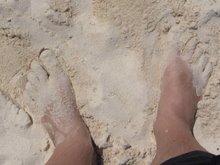[Disclaimer: if you are not into computers, don't read this. It will bore you to death]
I recently came across a post on a forum of users advising somebody to throw away his 'old' PC (pentium 1.4G with 64MB gpu) in order to get the new Windows Vista. Everybody gets it wrong; it is not about getting a computer to have Vista, it is about having a computer to do your freaking job.
I purchased an old IBM ThinkPad 770 laptop with a pentium 266, 96MB RAM, 4Gb hard drive, only floppy (no CDROM), two PCMCIA cards (LAN and modem). This piece of junk has half the power of my PDA for drying out loud! I gave $30 to get it and then $20 for a power adapter (the original was lost, and the battery doesn't hold a charge). Probably $50 is too much for this machine (aka The Brick), but the feeling of giving birth to something dead is priceless.
I tried using Windows 95 for 2 minutes and then I decided to make this actually usable. I am not that experienced with linux distos, but I have given it a try in the past (redhat and, mostly, ubuntu). Of course without a CDROM, there were not much I could do; my usual method of downloading the iso and making a boot/install CD was not an option. So, looking around I found this and decided to install Debian 3.1 using the PCMCIA lan card.
Step 1.
Obtain the img files for the three floppies I will need, boot, root and network drivers.
(this will only work for i386 CPU - for other types check here)
Make the floppies using the program rwwrtwin.
Step 2.
Insert the floppy boot into the drive and reboot the computer. When prompted insert the root floppy and when asked for additional drivers use the net-drivers floppy. It is crucial that by that point you already have your computer hooked up to the network, using a lan cable.
I have also done this using my iBook to connect to a wireless network and then share internet through the ethernet port of the iBook, where I hooked the IBM.
The installation should now begin. Select one of the servers to download the necessary files from (I used the MIT one, since it is fast - obviously - and close to my location).
Follow the directions from then on.
When prompted to pick a task to download appropriate files, select "Select packages manually" to start up Aptitude and from there choose what you need to avoid bloating your computer. If you don't care, then maybe selecting "Desktop" in the tasks would also work for you, but I don't recommend it. Aptitude is the best thing in debian so you might as well start using it as soon as possible. Before you install anything update the cache (pressing u).
Step 3.
Suggestions for old hardware:
Search (pressing / ) and mark for download (pressing +) the following
x-window-system-core this will install a basic X system on your machine
gdm this is a login manager - you don't need this one (you can use xdm or simply type startx every time you turn on your computer after you login) but I think this is disk space well spent
xfce4 this is a desktop environment (not just a window manager) that is very slick and fast, so I really like it in contrast to gnome/kde (you can try fluxbox, blackbox or anything else you like)
dillo very lightweight internet browser
links text based internet browser
qtorrent resources-friendly torrent client with gui
leaftpad very fast text editor (although I nano most of the times)
Step 4.
To get X working properly I had to manually edit the configuration file.
Login as root.
cd /etc/X11/
(or locate XF86config and cd to that folder)
Make sure that these sections are part of your file or that your monitor, graphics card and screen are configured in this way (only for IBM TP 770 users). Thanks to Martin Fluch for having this config on his website. I have edited the file based on my preferences and have it ready for you. Don't use it as is, but change your XF86Config-4 based on it.
UPDATE:
11/01/08 I have now updated my IBM to running Lenny. Since I had trouble finding floppies for netinstall, I used the etch floppies, and did minimal install by selecting no package in dselect (not even base or minimal). Then, after rebooting (this is probably a bad habbit from the winblows era), I edited the /etc/apt/sources.list file and changed the word etch or stable with lenny. Then I did aptitude update
aptitude dist-upgrade
aptitude upgrade
I have to say that it now I have a lot more features on rtorrent (mainly encryption) which is the main thing I use on that machine.




3 comments:
Hello. Thank for the interesting information on getting Debian Sarge to work on an IBM ThinkPad 770. I recently installed Debian Etch on a 770, but I find that the screen display is only one half the size (it's not fullscreen). Do you know how I can fix this?
Hi. I just recently asked about getting fullscreen on an IBM ThinkPad 770 with Debian. In reading through your post, and following the links you provided, I did find an answer that I'm going to try, that being to add some variation of the following:
image=/vmlinuz
label=Linux
vga=0x305
append="mem=97728k"
read-only
to my /boot/grub/menu.lst file. Or perhaps there's a different place where this information goes? Anyway, thanks for giving me something to work with.
@markg
Is the problem during boot or after X11 (kdm/gdm) loads? If the first, then changing the VGA settings in the grub configuration file will do it. Mine is still 50% because I only log on my machine through ssh.
I hope you figured out the solution to your problem.
Post a Comment